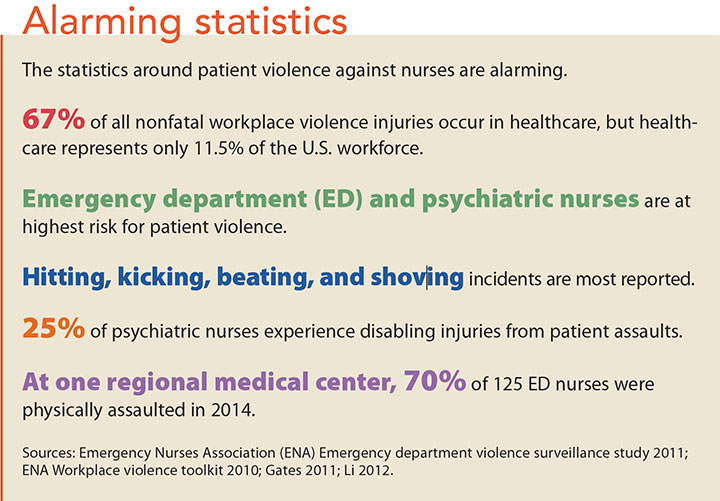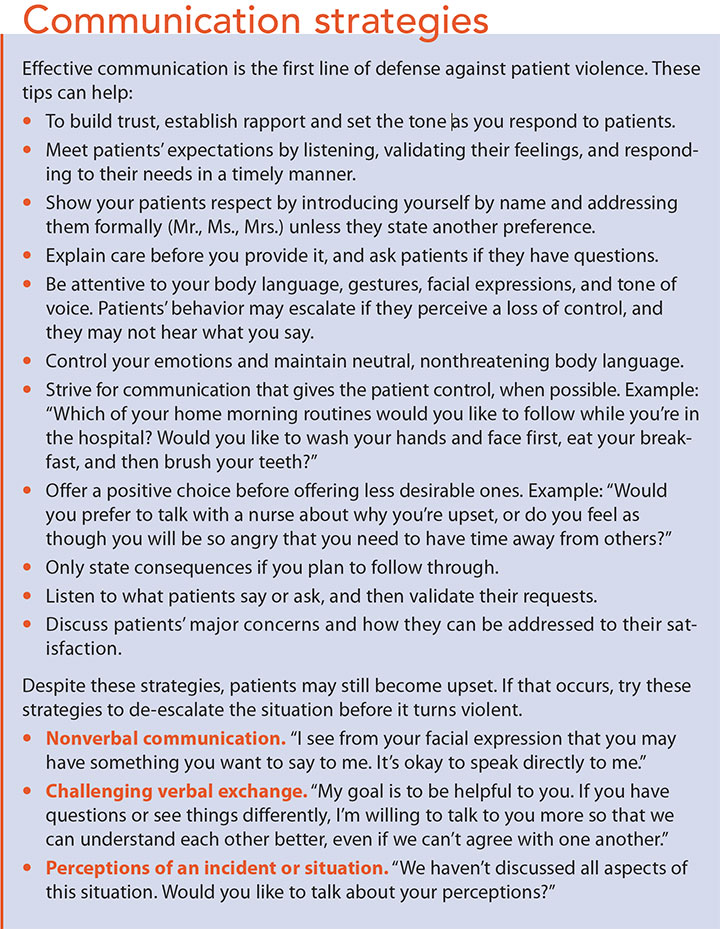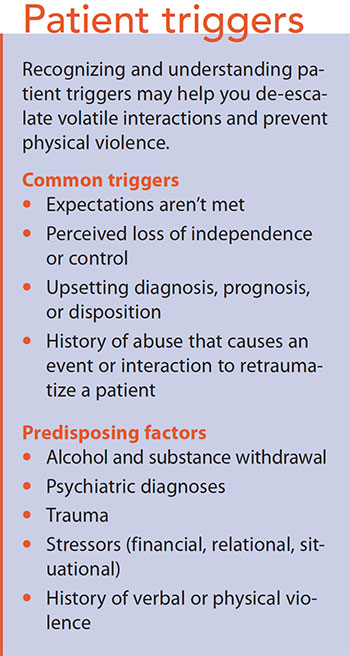Strategies for reducing patient violence and creating a safe workplace
Takeaways:
- Nurses alleviate stress when they report incidents of workplace violence.
- Nurses need to be proactive and expect their organizations to provide them with workplace violence prevention education, support when they are traumatized, and debrief to minimize future incidents.
By Lori Locke, MSN, RN, NE-BC; Gail Bromley, PhD, RN; Karen A. Federspiel, DNP, MS, RN-BC, GCNS-BC


These kinds of nurse-patient interactions occur in healthcare settings across the United States, and nurses all too frequently minimize their seriousness. However, according to the National Institute for Occupational Safety and Health, “…the spectrum [of violence]…ranges from offensive language to homicide, and a reasonable working definition of workplace violence is as follows: violent acts, including physical assaults and threats of assault, directed toward persons at work or on duty.” In other words, patient violence falls along a continuum, from verbal (harassing, threatening, yelling, bullying, and hostile sarcastic comments) to physical (slapping, punching, biting, throwing objects). As nurses, we must change our thinking: It’s not all in a day’s work.
This article focuses on physical violence and offers strategies you can implement to minimize the risk of being victimized.
Consequences of patient violence
In many cases, patients’ physical violence is life-changing to the nurses assaulted and those who witness it. (See Alarming statistics.) As a result, some nurses leave the profession rather than be victimized—a major problem in this era of nursing shortages.


Too frequently, nurses consider physical violence a symptom of the patient’s illness—even if they sustain injuries—so they don’t submit incident reports, and their injuries aren’t treated. Ultimately, physical and psychological insults result in distraction, which contributes to a higher incidence of medication errors and negative patient outcomes. Other damaging consequences include moral distress, burnout, and job dissatisfaction, which can lead to increased turnover. However, when organizations encourage nurses to report violence and provide education about de-escalation and prevention, they’re able to alleviate stress.
Workplace violence prevention
Therapeutic communication and assessment of a patient’s increased agitation are among the early clinical interventions you can use to prevent workplace violence. Use what you were taught in nursing school to recognize behavioral changes, such as anxiety, confusion, agitation, and escalation of verbal and nonverbal signs. Individually or together, these behaviors require thoughtful responses. Your calm, supportive, and responsive communication can de-escalate patients who are known to be potentially violent or those who are annoyed, angry, belligerent, demeaning, or are beginning to threaten staff. (See Communication strategies.)


Other strategies to prevent workplace violence include applying trauma-informed care, assessing for environmental risks, and recognizing patient triggers.
Trauma-informed care
Trauma-informed care considers the effects of past traumas patients experienced and encourages strategies that promote healing.
The Substance Abuse and Mental Health Services Administration says that a trauma-informed organization:
- realizes patient trauma experiences are widespread
- recognizes trauma signs and symptoms
- responds by integrating knowledge and clinical competencies about patients’ trauma
- resists retraumatization by being sensitive to interventions that may exacerbate staff-patient interactions.
This approach comprises six principles: safety; trustworthiness and transparency; peer support; collaboration and mutuality; empowerment, voice, and choice; and cultural, historical, and gender issues. Applying these principles will enhance your competencies so that you can verbally intervene to avoid conflict and minimize patient retraumatization. For more about trauma-informed care, visit samhsa.gov/nctic/trauma-interventions.
Environmental risks
To ensure a safe environment, identify objects in patient rooms and nursing units that might be used to injure someone. Chairs, footstools, I.V. poles, housekeeping supplies, and glass from lights or mirrors can all be used by patients to hurt themselves or others. Remove these objects from all areas where violent patients may have access to them.


Awareness of patient triggers will help you anticipate how best to interact and de-escalate. (See Patient triggers.) Share detailed information about specific patient triggers during handoffs, in interdisciplinary planning meetings, and with colleagues in safety huddles.
What should you do?
You owe it to yourself and your fellow nurses to take these steps to ensure that your physical and psychological needs and concerns are addressed:
- Know the definition of workplace violence.
- Take care of yourself if you’re assaulted by a patient or witness violence.
- Discuss and debrief the incident with your nurse manager, clinical supervisor, and colleagues.
- Use the healthcare setting’s incident reporting to report and document violent incidents and injuries.
- File charges based on your state’s laws.
Your organization should provide adequate support to ensure that when a nurse returns to work after a violent incident, he or she is able to care for patients. After any violent episode, staff and nurse leaders should participate in a thorough discussion of the incident to understand the dynamics and root cause and to be better prepared to minimize future risks. Effective communication about violent patient incidents includes handoffs that identify known risks with specific patients and a care plan that includes identified triggers and clinical interventions.
Influence organizational safety
You and your nurse colleagues are well positioned to influence your organization’s culture and advocate for a safe environment for staff and patients. Share these best practices with your organization to build a comprehensive safety infrastructure.
- Establish incident-reporting systems to capture all violent incidents.
- Create interprofessional workplace violence steering committees.
- Develop organizational policies and procedures related to safety and workplace violence, as well as human resources support.
- Provide workplace violence-prevention and safety education using evidence-based curriculum.
- Design administrative, director, and manager guidelines and responsibilities regarding communication and staff support for victims of patient violence and those who witness it.
- Use rapid response teams (including police, security, and protective services) to respond to violent behaviors.
- Delineate violence risk indicators to proactively identify patients with these behaviors.
- Create scorecards to benchmark quality indicators and outcomes.
- Post accessible resources on the organization’s intranet.
- Share human resources contacts.
Advocate for the workplace you deserve
Physically violent patients create a workplace that’s not conducive to compassionate care, creating chaos and distractions. Nurses must advocate for a culture of safety by encouraging their organization to establish violence-prevention policies and to provide support when an incident occurs.
You can access violence-prevention resources through the American Nurses Association, Emergency Nurses Association, Centers for Disease Control and Prevention, and the National Institute for Occupational Safety and Health. Most of these organizations have interactive online workplace violence-prevention modules. (See Resources.) When you advocate for safe work environments, you protect yourself and can provide the care your patients deserve.
Resources
|
The authors work at University Hospitals of Cleveland in Ohio. Lori Locke is the director of psychiatry service line and nursing practice. Gail Bromley is the codirector of nursing research and educator. Karen A. Federspiel is a clinical nurse specialist III.
Selected references
Cafaro T, Jolley C, LaValla A, Schroeder R. Workplace violence workgroup report. 2012.
Emergency Nurses Association. ENA toolkit: Workplace violence. 2010.
Emergency Nurses Association, Institute for Emergency Nursing Research. Emergency Department Violence Surveillance Study. 2011.
Gates DM, Gillespie GL, Succop P. Violence against nurses and its impact on stress and productivity. Nurs Econ. 2011;29(2):59-66.
National Institute for Occupational Safety and Health. Violence in the workplace: Current intelligence bulletin 57. Updated 2014.
Occupational Safety and Health Administration. Guidelines for Preventing Workplace Violence for Healthcare and Social Service Workers. 2016.
Speroni KG, Fitch T, Dawson E, Dugan L, Atherton M. Incidence and cost of nurse workplace violence perpetrated by hospital patients or patient visitors. J Emerg Nurs. 2014;40(3):218-28.
Substance Abuse and Mental Health Services Administration. Trauma-informed approach and trauma-specific interventions. Updated 2015.
Wolf LA, Delao AM, Perhats C. Nothing changes, nobody cares: Understanding the experience of emergency nurses physically or verbally assaulted while providing care. J Emerg Nurs. 2014;40(4):305-10.
ant5-Patient Violence-430



















2 Comments.
I am writing to you in response to the article “Patient violence: It’s not all in a day’s work” by Locke, L., MSN, RN NE-BC, Bromley, G., PhD, RN, & Federspiel, K., DNP, MS, RN-BC, GCNS-BC published May 2018 in volume 13 number 5. Providing nursing care in a busy level II trauma center emergency department, I am acutely aware of the prevalence of violence toward staff. The article shockingly reveals that “67% of all nonfatal workplace violence injuries occur in healthcare, but healthcare represents only 11.5% of the U.S. workforce,” exposing the vast disproportion of workplace injuries in relation to the field of health-care. Nurses and employers cannot afford to continue this culture of acceptance with regards to patient violence. I support the use of workplace violence prevention committees to increase safety for healthcare workers by assessing barriers to reporting violent incidents and ensuring appropriate follow up when reporting does occur.
As suggested in the article, workplace violence prevention committees are essential to providing the necessary ongoing assessments of staff safety as well as follow up to any incidents that occur. The Emergency Nurses Association provides a wealth of resources within their online Workplace Violence toolkit, including a printable staff assessment survey addressing various aspects of violence toward staff and barriers to reporting incidents. In response to the article’s call for influencing organizational safety by sharing best practices, I plan to present the ENA’s staff assessment survey to my organization as a starting point for proposing a workplace violence committee. The ENA’s 2010 Workplace Violence Surveillance Study revealed many nurses did not report violent incidents because they did not believe it was beneficial to do so. This culture holds true for the emergency nurses and staff I work alongside, despite the presence of reporting procedures and an online system to do so. Without a committee assessing barriers and educating nurses of the importance of reporting, this culture of under-reporting will remain.
In conclusion, American Nurse Today published the article “Patient violence: It’s not all in a day’s work” at this pivotal time where we must hold each other and our organizations accountable for changing the culture regarding patient violence toward staff. It truly is not all in a day’s work and we must take the initiative to begin discussions about culture change and the importance of reporting violent incidents. Nurses must advocate for essential workplace violence prevention committees to ensure ongoing assessment and follow up of incidents, securing a culture of safety for both patients and staff alike.
Respectfully,
Camellia Austin, RN, CEN, CPEN, TCRN
I am writing to you in response to the article “Patient violence: It’s not all in a day’s work” by Locke, Bromley, & Federspiel, from the May 2018 issue of American Nurse Today. My professional reaction to this article is one of support, familiarity, and also a bit of astonishment. Though I was both personally and professionally aware of the violence issues we face as nurses, I am appalled at the actual statistics. What’s worse than the statistics is the fact that the Joint Commission believes them to be higher than published, due to underreporting. I’ve been the victim of patient violence, and this article inspired me to learn more about the problem we face and find some ways to work on it. It is time that we join together, grab the reigns, and demand some positive changes in this situation.
The three topics I found to be recurring themes in my research were the people, the available opportunities, and staffing. In the recently published “Sentinel Event” (59) by the Joint Commission, one of the factors prone to leading to violence is the presence of domestic disputes or issues between patients and visitors. This is one of the stressors we can neither prepare for, nor completely eliminate from our working environment. The Robert Wood Johnson Foundation published an article in July of 2015 titled “Nurses Face Epidemic Levels of Violence at Work” that suggested that long periods of face to face interaction could contribute to the risk for exposure to violence. Clearly, in the nursing profession, limiting time spent in close proximity to our patients would impact the quality of patient care in a negative way. Nurse-patient ratios are only a fraction of the staffing portion of this trend. The aging population in need of healthcare has been on the rise for many years. The average age of nurses is also continually rising. Soon, there will be more nurses retiring than there are new ones to replace them. Higher nurse-patient ratios make us less available to spend time providing the type of care that our patients expect and deserve. As mentioned in your publication, these higher ratios also contribute to delays that lead to patient and visitor frustration, and potentially increase the risk of violence, which we are also not available to deescalate. Patients and visitors will remain an unknown variable. We will continue to be the front line of healthcare, spending the most face time with the patients. Staffing is something we have to fight for.
We should also be looking for solutions beyond the bedside. A prime example is the safety and security of the working environment. Shouldn’t a hospital be as safe as a court house? Metal detectors at all entrances, instead of just emergency rooms would deter those with weapons. More video surveillance and foot patrols in hospitals would discourage some of the violence we’ve been subjected to. All of these safety measures require an increase in security staffing. The decrease in workers’ compensation lawsuits, lost time from work due to injuries, and decrease in training expenses caused by turnover should offset the increased staffing. This is just one example. When we as a profession come together to share ideas, there will surely be more solutions to propose.
I sincerely hope that this article created the same sense of shock & awe in other professionals that it did in me. There are certainly some aspects of our work that we cannot change, such as the patient & visitor variables and the close proximity to our patients. However, there are other areas where we can influence change. It’s time we stand up for ourselves. Thank you for bringing attention to this topic, so we may all become vigilant in our own safety.
Sincerely,
Shannon N. Chestnut, RN